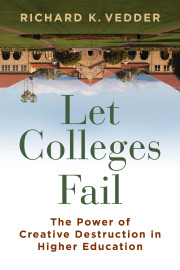Although our national motto, E Pluribus Unum, appropriately reflects how diverse peoples have melded together to form a tribe that we call “Americans,” that does not negate the fact that there are numerous different ways we carry out the business of life across our vast land. That is especially true regarding the provision of higher education services.
Going to college in Connecticut, in many ways, is different from doing so in West Virginia, Oklahoma, or California. In higher education, Justice Louis Brandeis’s “laboratory of democracy” description based on America’s federal system of 50 state governments may be a more appropriate framework to assess performance than E Pluribus Unum.
Indeed, I think it fortunate that the U.S. Department of Education has been largely unsuccessful in efforts to centralize and homogenize our diverse system of universities. In education, as in most endeavors, variety is the spice of life.
States that literally border each other often have radically different higher education profiles.
Virginia has the sixth highest proportion of adults with college degrees, but its neighbor, West Virginia, with which it shares an extensive border, has the lowest proportion of adults with bachelor’s degrees of any state. Similarly, Colorado has the second highest proportion of college graduates, while neighboring New Mexico is in the bottom ten states.
While as a general proposition, it is true that “blue”—liberal and Democratic—states have a larger proportion of college graduates than “red”—more conservative and Republican—ones, that too disguises many big anomalies. Liberal Massachusetts has the highest proportion of college graduates, but its state government historically has spent dramatically fewer dollars per capita on higher education than, say, very conservative Mississippi, our poorest state with less than half the proportion of adults with bachelor’s degrees as Massachusetts.
While the New England states have a deserved reputation for being left-of-center politically, a large proportion of their adults attended private colleges. While Mississippi and Alabama are reliably conservative states, but they spend far more taxpayer dollars on higher education per capita than blue northeastern states like New Jersey or Massachusetts.
It is interesting that the area of the country with the greatest reputation for higher education quality—the Northeast—has shown the least appetite for strong public support for colleges and universities. Young residents of the Bay State might ask: why go to a campus of the University of Massachusetts or Bridgewater State University when there are many qualitatively much higher ranked universities like Harvard, M.I.T., Tufts, or Brandeis, or colleges like Boston, Williams, or Amherst located nearby where average graduate earnings are far higher than at the state schools, making those schools good values despite higher tuition fees?
In addition to the dramatically varying importance of private school higher education in our country, interstate and international migration is a second major factor explaining some of the vast differences in the higher education environment.
States like Colorado, for example, have attracted large numbers of highly educated technical and professional people from other states, such as midwestern locales like Michigan or Illinois.
All of this leads me to wonder: why do state governments even fund universities?
Large portions of graduates of most universities move to other states. Why should the citizens of Kansas subsidize local children attending Kansas or Kansas State universities, only to see many of them move right after graduation to, say, Texas or Colorado? In their move to derive more tuition money, many schools have greatly increased their out-of-state enrollments, so, at, say, schools in the Dakotas or Alabama, they sometimes now outnumber fellow students born in the state in which the university is located.
Similarly, students born in other countries form an important portion of the student body at many schools, especially well-known research-oriented institutions. Long overdue reform of our immigration laws could potentially become an important factor in reducing a likely national enrollment drop arising from a declining number of college-aged students in the next decade.
While the rationale for American-style so-called “state” universities may seem somewhat suspect, personally, I rejoice in the enhanced competition and intellectual variety offered by having schools managed in a relatively diverse fashion with widely varying educational philosophies and competencies. Better 50 different government-run models for schools than simply one. Add in many hundreds of private schools, you get still more competition and diverse approaches to learning and discovery.
As the French sometimes say, vive la difference!













